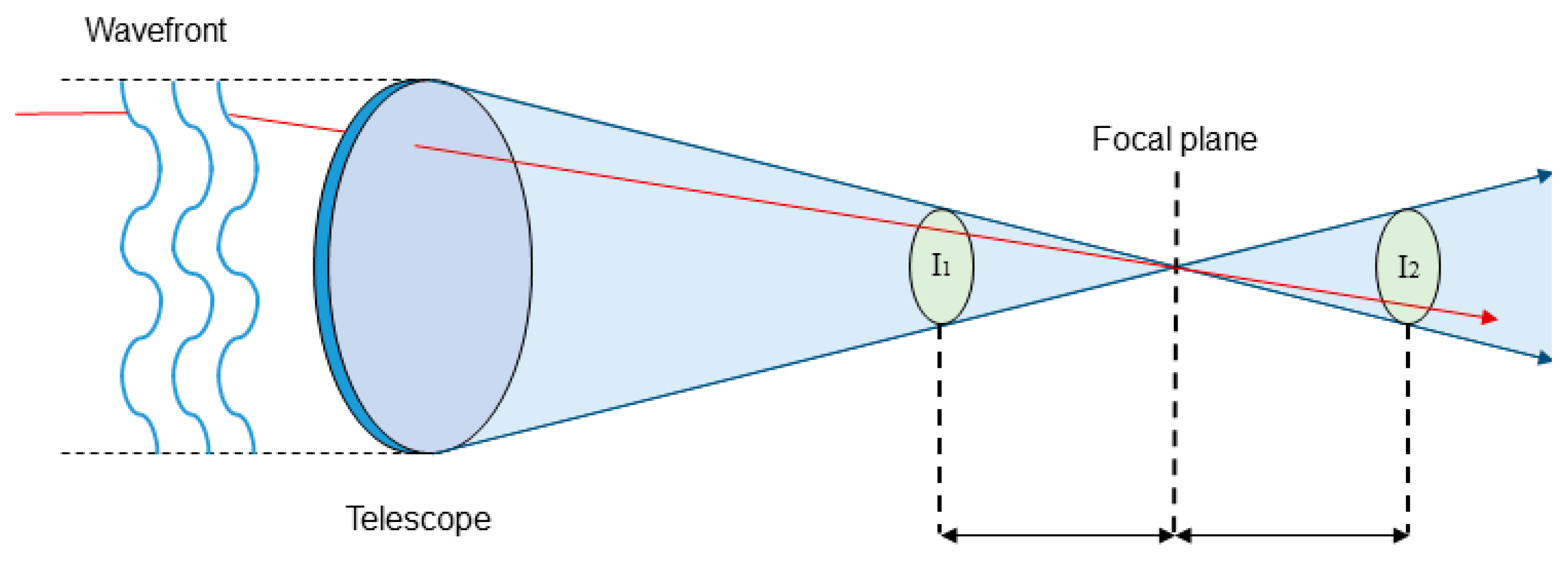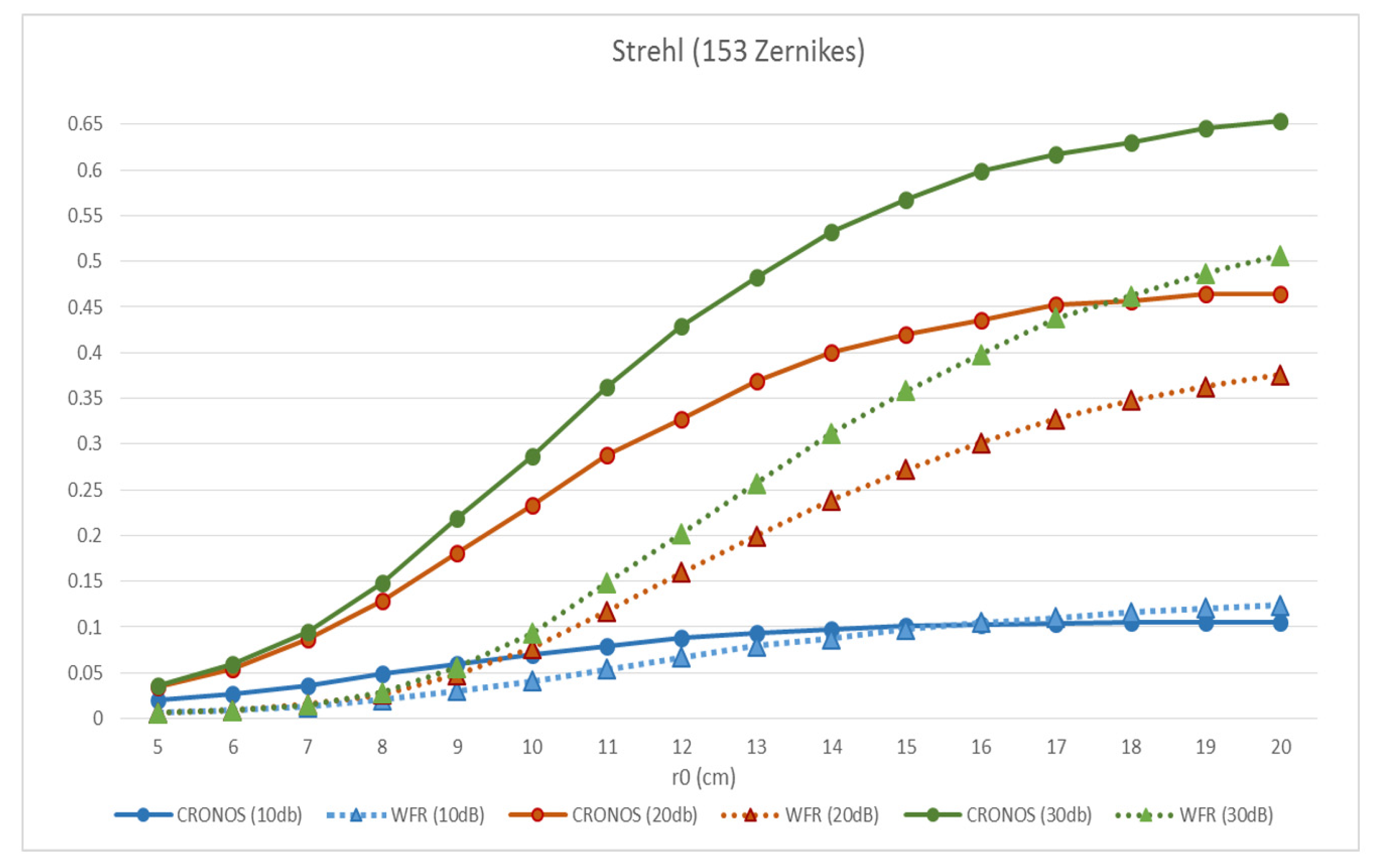Defocused Image Deep Learning Designed for Wavefront Reconstruction in Tomographic Pupil Image Sensors
Abstract
1. Introduction
2. Materials and Methods
2.1. Adaptive Optics Systems
2.2. TPI-WFS
2.3. Deep Learning
2.4. Simulations and Network Training
3. Results
3.1. Results for Reconstruction with 153 Zernike Modes
3.2. Results for Reconstruction with 153 Zernike Modes Including Noise
4. Discussion
5. Conclusions and Future Lines of Research
Author Contributions
Funding
Institutional Review Board Statement
Informed Consent Statement
Data Availability Statement
Conflicts of Interest
References
- Roddier, C.; Roddier, F. Wave-front reconstruction from defocused images and the testing of ground-based optical telescopes. JOSA A 1993, 10, 2277–2287. [Google Scholar] [CrossRef]
- Fernández-Valdivia, J.J.; Trujillo-Sevilla, J.M.; Casanova-González, O.; López, R.L.; Velasco, S.; Colodro-Conde, C.; Puga, M.; Oscoz, A.; Rebolo, R.; Mackay, C.; et al. Real time phase compensation using a tomographical pupil image wavefront sensor (TPI-WFS). In Proceedings of the Information Optics (WIO), 2016 15th Workshop, Barcelona, Spain, 11–15 July 2016; pp. 1–2. [Google Scholar]
- Fernández-Valdivia, J.J.; Sedano, A.L.; Chueca, S.; Gil, J.S.; Ridriguez-Ramos, J.M. Tip-tilt restoration of a segmented optical mirror using a geometric sensor. Opt. Eng. 2013, 52, 56601. [Google Scholar] [CrossRef]
- Colodro-Conde, C.; Velasco, S.; Fernández-Valdivia, J.J.; López, R.; Oscoz, A.; Rebolo, R.; Femenía, B.; King, D.L.; Labadie, L.; Mackay, C.; et al. Laboratory and telescope demonstration of the TP3-WFS for the adaptive optics segment of AOLI. Mon. Not. R. Astron. Soc. 2017, 467, 2855–2868. [Google Scholar] [CrossRef]
- Lasheras, J.E.S.; Donquiles, C.G.; Nieto, P.J.G.; Moleon, J.J.J.; Salas, D.; Gómez, S.L.S.; de la Torre, A.J.M.; González-Nuevo, J.; Bonavera, L.; Landeira, J.C.; et al. A methodology for detecting relevant single nucleotide polymorphism in prostate cancer with multivariate adaptive regression splines and backpropagation artificial neural networks. Neural Comput. Appl. 2018, 32, 1231–1238. [Google Scholar] [CrossRef]
- De Andrés, J.; Sánchez-Lasheras, F.; Lorca, P.; De Cos Juez, F.J. A hybrid device of Self Organizing Maps (SOM) and Multivariate Adaptive Regression Splines (MARS) for the forecasting of firms’ bankruptcy. Account. Manag. Inf. Syst. 2011, 10, 351. [Google Scholar]
- Artime Ríos, E.M.; del Mar Seguí Crespo, M.; Suárez Sánchez, A.; Suárez Gómez, S.L.; Sánchez Lasheras, F. Genetic algorithm based on support vector machines for computer vision syndrome classification. In Proceedings of the International Joint Conference SOCO’17-CISIS’17-ICEUTE’17, León, Spain, 6–8 September 2017; pp. 381–390. [Google Scholar]
- Mirowski, P.W.; LeCun, Y.; Madhavan, D.; Kuzniecky, R. Comparing SVM and convolutional networks for epileptic seizure prediction from intracranial EEG. In Proceedings of the Machine Learning for Signal Processing, 2008. MLSP 2008. IEEE Workshop, Cancun, Mexico, 16–19 October 2008; pp. 244–249. [Google Scholar]
- Nagi, J.; Ducatelle, F.; Di Caro, G.A.; Cireçsan, D.; Meier, U.; Giusti, A.; Nagi, F.; Schmidhuber, J.; Gambardella, L.M. Max-pooling convolutional neural networks for vision-based hand gesture recognition. In Proceedings of the Signal and Image Processing Applications (ICSIPA), 2011 IEEE International Conference, Kuala Lumpur, Malaysia, 16–18 November 2011; pp. 342–347. [Google Scholar]
- Krizhevsky, A.; Sutskever, I.; Hinton, G.E. Imagenet classification with deep convolutional neural networks. In Proceedings of the Advances in Neural Information Processing Systems, Lake Tahoe, NV, USA, 3–6 December 2012; pp. 1097–1105. [Google Scholar]
- LeCun, Y.; Bengio, Y.; Hinton, G. Deep learning. Nature 2015, 521, 436–444. [Google Scholar] [CrossRef] [PubMed]
- Guo, H.; Korablinova, N.; Ren, Q.; Bille, J. Wavefront reconstruction with artificial neural networks. Opt. Express 2006, 14, 6456–6462. [Google Scholar] [CrossRef]
- Suárez Gómez, S.L.; González-Gutiérrez, C.; Díez Alonso, E.; Santos Rodríguez, J.D.; Sánchez Rodríguez, M.L.; Morris, T.; Osborn, J.; Basden, A.; Bonavera, L.; González-Nuevo González, J.; et al. Experience with Artificial Neural Networks applied in Multi-Object Adaptive Optics. Publ. Astron. Soc. Pacific 2019, 131, 108012. [Google Scholar] [CrossRef]
- Osborn, J.; De Cos Juez, F.J.; Guzman, D.; Butterley, T.; Myers, R.; Guesalaga, A.; Laine, J. Using artificial neural networks for open-loop tomography. Opt. Express 2012, 20, 2420. [Google Scholar] [CrossRef]
- de Cos Juez, F.J.; Lasheras, F.S.; Roqueñí, N.; Osborn, J. An ANN-based smart tomographic reconstructor in a dynamic environment. Sensors 2012, 12, 8895–8911. [Google Scholar] [CrossRef]
- Osborn, J.; Guzman, D.; de Cos Juez, F.J.; Basden, A.G.; Morris, T.J.; Gendron, E.; Butterley, T.; Myers, R.M.; Guesalaga, A.; Sánchez Lasheras, F.; et al. Open-loop tomography with artificial neural networks on CANARY: On-sky results. Mon. Not. R. Astron. Soc. 2014, 441, 2508–2514. [Google Scholar] [CrossRef]
- Suárez Gómez, S.L.; Santos Rodríguez, J.D.; Iglesias Rodríguez, F.J.; de Cos Juez, F.J. Analysis of the Temporal Structure Evolution of Physical Systems with the Self-Organising Tree Algorithm (SOTA): Application for Validating Neural Network Systems on Adaptive Optics Data before On-Sky Implementation. Entropy 2017, 19, 103. [Google Scholar] [CrossRef]
- Rodríguez Ramos, L.F.; González-Gutiérrez, C.; Suárez Gómez, S.L.; Férnández Valdivia, J.J.; Rodríguez Ramos, J.M.; De Cos Juez, F.J. New adaptive optics Tomographic Pupil Image reconstructor based on convolutional neural networks. In Proceedings of the Adaptive Optics for Extremely Large Telescopes 5; Instituto de Astrofísica de Canarias (IAC): San Cristobal de La Laguna, Spain, June 2017. [Google Scholar]
- Noll, R.J. Zernike polynomials and atmospheric turbulence. JOsA 1976, 66, 207–211. [Google Scholar] [CrossRef]
- Guzmán, D.; de Cos Juez, F.J.; Myers, R.; Guesalaga, A.; Lasheras, F.S. Modeling a MEMS deformable mirror using non-parametric estimation techniques. Opt. Express 2010, 18, 21356–21369. [Google Scholar] [CrossRef]
- Basden, A.G.; Atkinson, D.; Bharmal, N.A.; Bitenc, U.; Brangier, M.; Buey, T.; Butterley, T.; Cano, D.; Chemla, F.; Clark, P.; et al. Experience with wavefront sensor and deformable mirror interfaces for wide-field adaptive optics systems. Mon. Not. R. Astron. Soc. 2016, 459, 1350–1359. [Google Scholar] [CrossRef]
- Hippler, S.; Feldt, M.; Bertram, T.; Brandner, W.; Cantalloube, F.; Carlomagno, B.; Absil, O.; Obereder, A.; Shatokhina, I.; Stuik, R. Single conjugate adaptive optics for the ELT instrument METIS. Exp. Astron. 2018. [Google Scholar] [CrossRef]
- Guzmán, D.; de Cos Juez, F.J.; Lasheras, F.S.; Myers, R.; Young, L. Deformable mirror model for open-loop adaptive optics using multivariate adaptive regression splines. Opt. Express 2010, 18, 6492–6505. [Google Scholar] [CrossRef]
- Davies, R.; Kasper, M. Adaptive optics for astronomy. Annu. Rev. Astron. Astrophys. 2012, 50, 305–351. [Google Scholar] [CrossRef]
- Ellerbroek, B.L. First-order performance evaluation of adaptive-optics systems for atmospheric-turbulence compensation in extended-field-of-view astronomical telescopes. JOSA A 1994, 11, 783–805. [Google Scholar] [CrossRef]
- Vidal, F.; Gendron, E.; Rousset, G. Tomography approach for multi-object adaptive optics. JOSA A 2010, 27, A253–A264. [Google Scholar] [CrossRef]
- Suárez Gómez, S.L.; Gutiérrez, C.G.; Rodríguez, J.D.S.; Rodríguez, M.L.S.; Lasheras, F.S.; de Cos Juez, F.J. Analysing the Performance of a Tomographic Reconstructor with Different Neural Networks Frameworks. In Proceedings of the International Conference on Intelligent Systems Design and Applications, Jinan, China, 16–18 October 2016; pp. 1051–1060. [Google Scholar]
- Ramsay, S.K.; Casali, M.M.; González, J.C.; Hubin, N. The E-ELT instrument roadmap: A status report. In Proceedings of the Ground-based and Airborne Instrumentation for Astronomy V, Montreal, QC, Canada, 22–26 June 2014; Volume 9147, p. 91471Z. [Google Scholar]
- Osborn, J.; Juez, F.J.D.C.; Guzman, D.; Butterley, T.; Myers, R.; Guesalaga, A.; Laine, J. Open-Loop Tomography Using Artificial Nueral Networks. 2011. Available online: http://ao4elt2.lesia.obspm.fr/sites/ao4elt2/IMG/pdf/089osborn.pdf (accessed on 23 December 2020).
- González-Gutiérrez, C.; Santos-Rodríguez, J.D.; Díaz, R.Á.F.; Rolle, J.L.C.; Gutiérrez, N.R.; de Cos Juez, F.J. Using GPUs to Speed up a Tomographic Reconstructor Based on Machine Learning. In Proceedings of the International Conference on EUropean Transnational Education, León, Spain, 6–8 September 2016; pp. 279–289. [Google Scholar]
- González-Gutiérrez, C.; Santos Rodríguez, J.D.; Martínez-Zarzuela, M.; Basden, A.G.; Osborn, J.; Díaz-Pernas, F.J.; De Cos Juez, F.J. Comparative Study of Neural Network Frameworks for the Next Generation of Adaptive Optics Systems. Sensors 2017, 17, 1263. [Google Scholar] [CrossRef] [PubMed]
- González-Gutiérrez, C.; Sánchez-Rodríguez, M.L.; Calvo-Rolle, J.L.; de Cos Juez, F.J. Multi-GPU Development of a Neural Networks Based Reconstructor for Adaptive Optics. Complexity 2018, 2018, 1–9. [Google Scholar] [CrossRef]
- Van Dam, M.A.; Lane, R.G. Wave-front sensing from defocused images by use of wave-front slopes. Appl. Opt. 2002, 41, 5497–5502. [Google Scholar] [CrossRef] [PubMed]
- Van Dam, M.A.; Lane, R.G. Extended analysis of curvature sensing. JOSA A 2002, 19, 1390–1397. [Google Scholar] [CrossRef]
- Zernike, F. Diffraction theory of the knife-edge test and its improved form, the phase-contrast method. Mon. Not. R. Astron. Soc. 1934, 94, 377–384. [Google Scholar] [CrossRef]
- Helgason, S. The Radon transform on Rn. In Integral Geometry and Radon Transforms; Springer: Berlin/Heidelberg, Germany, 2011; pp. 1–62. [Google Scholar]
- Abraham, T.H. (Physio) logical circuits: The intellectual origins of the McCulloch--Pitts neural networks. J. Hist. Behav. Sci. 2002, 38, 3–25. [Google Scholar] [CrossRef]
- Zhang, L.; Zhang, B. A geometrical representation of McCulloch-Pitts neural model and its applications. IEEE Trans. Neural Netw. 1999, 10, 925–929. [Google Scholar] [CrossRef]
- Leshno, M.; Lin, V.Y.; Pinkus, A.; Schocken, S. Multilayer feedforward networks with a nonpolynomial activation function can approximate any function. Neural Netw. 1993, 6, 861–867. [Google Scholar] [CrossRef]
- LeCun, Y.; Bengio, Y. Convolutional networks for images, speech, and time series. Handb. Brain Theory Neural Netw. 1995, 3361, 1995. [Google Scholar]
- Lecun, Y.; Bottou, L.; Bengio, Y.; Haffner, P. Gradient-based learning applied to document recognition. Proc. IEEE 1998, 86, 2278–2323. [Google Scholar] [CrossRef]
- Giusti, A.; Ciresan, D.C.; Masci, J.; Gambardella, L.M.; Schmidhuber, J. Fast image scanning with deep max-pooling convolutional neural networks. In Proceedings of the Image Processing (ICIP), 2013 20th IEEE International Conference, Melbourne, Australia, 15–18 September 2013; pp. 4034–4038. [Google Scholar]
- Graves, A.; Mohamed, A.; Hinton, G. Speech Recognition With Deep Recurrent Neural Networks. Icassp 2013, 6645–6649. [Google Scholar] [CrossRef]
- Nair, V.; Hinton, G.E. Rectified linear units improve restricted boltzmann machines. In Proceedings of the 27th international conference on machine learning (ICML-10), Haifa, Israel, 21–24 June 2010; pp. 807–814. [Google Scholar]
- Hornik, K.; Stinchcombe, M.; White, H. Multilayer feedforward networks are universal approximators. Neural Netw. 1989, 2, 359–366. [Google Scholar] [CrossRef]
- Chauvin, Y.; Rumelhart, D.E. Backpropagation: Theory, Architectures, and Applications; Psychology Press: East Sussex, UK, 2013. [Google Scholar]
- Ruder, S. An overview of gradient descent optimization algorithms. arXiv 2016, arXiv:1609.04747. [Google Scholar]
- Zhan, H.; Wijerathna, E.; Voelz, D. Is the formulation of the Fried parameter accurate in the strong turbulent scattering regime? OSA Contin. 2020, 3, 2653–2659. [Google Scholar] [CrossRef]
- Perrin, M.D.; Sivaramakrishnan, A.; Makidon, R.B.; Oppenheimer, B.R.; Graham, J.R. The structure of high Strehl ratio point-spread functions. Astrophys. J. 2003, 596, 702. [Google Scholar] [CrossRef]








Publisher’s Note: MDPI stays neutral with regard to jurisdictional claims in published maps and institutional affiliations. |
© 2020 by the authors. Licensee MDPI, Basel, Switzerland. This article is an open access article distributed under the terms and conditions of the Creative Commons Attribution (CC BY) license (http://creativecommons.org/licenses/by/4.0/).
Share and Cite
Suárez Gómez, S.L.; García Riesgo, F.; González Gutiérrez, C.; Rodríguez Ramos, L.F.; Santos, J.D. Defocused Image Deep Learning Designed for Wavefront Reconstruction in Tomographic Pupil Image Sensors. Mathematics 2021, 9, 15. https://doi.org/10.3390/math9010015
Suárez Gómez SL, García Riesgo F, González Gutiérrez C, Rodríguez Ramos LF, Santos JD. Defocused Image Deep Learning Designed for Wavefront Reconstruction in Tomographic Pupil Image Sensors. Mathematics. 2021; 9(1):15. https://doi.org/10.3390/math9010015
Chicago/Turabian StyleSuárez Gómez, Sergio Luis, Francisco García Riesgo, Carlos González Gutiérrez, Luis Fernando Rodríguez Ramos, and Jesús Daniel Santos. 2021. "Defocused Image Deep Learning Designed for Wavefront Reconstruction in Tomographic Pupil Image Sensors" Mathematics 9, no. 1: 15. https://doi.org/10.3390/math9010015
APA StyleSuárez Gómez, S. L., García Riesgo, F., González Gutiérrez, C., Rodríguez Ramos, L. F., & Santos, J. D. (2021). Defocused Image Deep Learning Designed for Wavefront Reconstruction in Tomographic Pupil Image Sensors. Mathematics, 9(1), 15. https://doi.org/10.3390/math9010015




